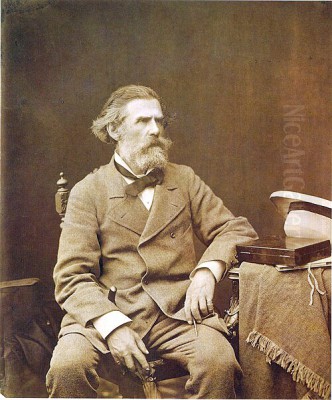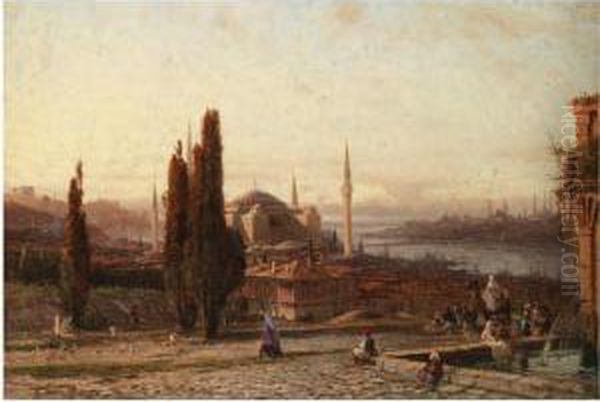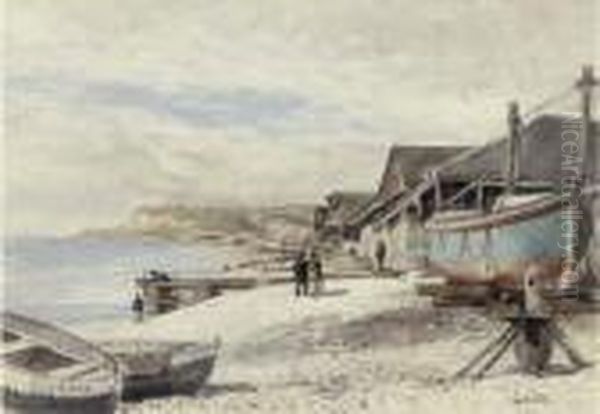
Aleksei Petrovich Bogolyubov stands as a significant figure in the landscape of 19th-century Russian art. Born into an era of artistic transition, he navigated the currents of Romanticism and Realism, leaving behind a legacy rich in maritime depictions and evocative natural scenes. His life, intertwined with both naval service and dedicated artistic pursuit, provided a unique perspective that shaped his celebrated body of work. As a painter, educator, and cultural benefactor, Bogolyubov's influence extended beyond his canvases, contributing significantly to the development and appreciation of Russian art.
Noble Roots and Naval Beginnings
Aleksei Bogolyubov was born on March 16, 1824, into a family with notable connections. His father, Pyotr Gavrilovich Bogolyubov, was a retired colonel. More significantly, his mother, Fekla Aleksandrovna Radishcheva, was the daughter of Alexander Radishchev, a renowned and controversial writer, sociologist, and philosopher of the Russian Enlightenment. This lineage perhaps instilled in the young Bogolyubov a sense of history and cultural awareness.
Following a path common for young men of his standing, Bogolyubov pursued a military education. He graduated from a military school in 1841 and subsequently embarked on a career in the Russian Navy. This period proved formative for his artistic inclinations. His service involved extensive travel, taking him aboard naval vessels to various parts of Europe, including the Netherlands, Portugal, and England, as well as the island of Madeira. These voyages exposed him to diverse coastlines, weather conditions, and the powerful majesty of the sea, experiences that would deeply inform his later artistic specialization.
Formal Artistic Education
Despite his naval career, Bogolyubov's passion for art grew. In 1849, while still in service, he made the pivotal decision to formally cultivate his talent by enrolling as an auditor at the prestigious Saint Petersburg Academy of Arts. There, he studied under the guidance of Maxim Vorobiev, a respected landscape painter known for his cityscapes and atmospheric scenes. Vorobiev's tutelage provided Bogolyubov with a solid foundation in academic technique and composition.

However, perhaps the most profound influence during his academic years came from Ivan Aivazovsky. Aivazovsky was already a celebrated master of the marine genre, renowned for his dramatic and luminous depictions of seascapes and naval battles. Bogolyubov deeply admired Aivazovsky's ability to capture the dynamic energy and sublime beauty of the ocean. While developing his own distinct style, the impact of Aivazovsky's romantic sensibility, particularly in rendering light and water, remained evident in Bogolyubov's work. He proved a dedicated student, graduating from the Academy in 1853 with a first-class gold medal, a testament to his exceptional skill.
European Sojourn and Artistic Encounters
Following his graduation, Bogolyubov was appointed as an artist to the Naval Headquarters, a position that acknowledged his unique blend of naval experience and artistic talent. The Academy also awarded him a fellowship, enabling him to travel abroad for further artistic development between 1854 and 1860. This period was crucial in broadening his horizons and refining his style.
His travels took him across Europe. He spent time in Geneva, absorbing the picturesque Swiss landscapes. He also worked in Düsseldorf, a major center for landscape painting at the time, potentially encountering the work of artists like Andreas Achenbach, known for his dramatic seascapes. However, his time in Paris proved particularly influential. There, Bogolyubov became acquainted with and deeply admired the artists of the Barbizon School.
The Barbizon painters, working in the forests near the village of Barbizon, advocated for a more direct and realistic approach to landscape painting, emphasizing plein air sketching and a truthful depiction of nature, light, and atmosphere. Bogolyubov formed significant friendships with leading figures of the movement, notably Camille Corot, celebrated for his lyrical landscapes and silvery light, and Charles-François Daubigny, known for his river scenes and proto-Impressionist brushwork. This exposure to French Realism tempered the inherent Romanticism in Bogolyubov's work, encouraging a greater focus on naturalistic observation and tonal subtlety.
A Career Between Sea and Studio
Upon returning to Russia in 1860, Bogolyubov brought back a wealth of experience and a refined artistic vision. He skillfully balanced his official duties as an artist for the Naval Headquarters, documenting Russian naval history and fleet activities, with his personal passion for landscape painting. His naval background gave his maritime scenes an unparalleled authenticity in their depiction of ships and naval procedures.
His artistic achievements and growing reputation earned him significant recognition within the Russian art establishment. In the 1860s, he was appointed a professor at the Imperial Academy of Arts, the very institution where he had trained. This role allowed him to mentor a new generation of artists. His standing was further solidified in 1871 when he was elected as an Academician, one of the highest honors conferred by the Academy.
From Romanticism to Realism

Bogolyubov's artistic journey reflects a broader shift occurring in European and Russian art during the 19th century. His early works often display the dramatic flair and heightened emotion characteristic of Romanticism, clearly influenced by Aivazovsky. He excelled at capturing the turbulent energy of storms at sea and the grandeur of naval spectacles.
However, his experiences in Europe, particularly his engagement with the Barbizon School, steered him towards a more grounded, realistic approach. His later landscapes and seascapes demonstrate a greater emphasis on accurate observation, nuanced light effects, and a more restrained palette. While never fully abandoning a sense of atmosphere and mood, his work gained a solidity and fidelity to nature characteristic of Realism. He became adept at capturing the specific light and atmosphere of different times of day and weather conditions, whether depicting the tranquil waters of a harbor or the bustling banks of the Neva River. He worked proficiently across various media, including oil painting, watercolor, and drawing, adapting his technique to the subject matter.
Engagement with The Wanderers (Peredvizhniki)
From 1870 onwards, Bogolyubov became closely associated with the Society for Travelling Art Exhibitions, better known as the Peredvizhniki or "The Wanderers." This influential group sought to break free from the perceived constraints of the Academy, promote Realism, depict contemporary Russian life and landscapes, and make art more accessible to the public by organizing travelling exhibitions.
Bogolyubov served as a member of the Peredvizhniki's governing board, indicating his commitment to their ideals. While his subject matter often focused on landscapes and historical naval scenes rather than the sharp social critique found in the works of some members like Vasily Perov or the intense psychological portraits by Ivan Kramskoi, his dedication to Realism aligned him with the movement's core artistic principles. He shared common ground with fellow landscape painters within the group, such as the masters of the Russian forest Ivan Shishkin, the lyrical Alexei Savrasov, and the later master of the "mood landscape," Isaac Levitan. His participation connected him with key figures like the great historical and genre painter Ilya Repin. Although associated with this progressive movement, some sources note that Bogolyubov retained relatively conservative social views compared to the more radical members of the group.
Iconic Works: Capturing Nature and History
Bogolyubov's extensive oeuvre includes numerous celebrated paintings that showcase his skill and thematic range. Venice at Night (also known as Venice la nuit) is an early, evocative piece demonstrating his mastery of nocturnal light effects and romantic atmosphere, likely painted during his European travels. The Monastery represents his engagement with traditional Russian landscapes and architectural motifs.
His naval background is prominent in historical works like Revel Fight May 7, 1790, a dynamic depiction of a significant naval battle, showcasing his ability to handle complex compositions involving multiple ships and dramatic action. Similarly, Explosion of a Turkish Warship on the Danube (1877) captures a specific event from the Russo-Turkish War with historical accuracy and dramatic intensity. These works served not only as artistic achievements but also as important visual records of Russian naval history, commissioned by the state.
Beyond grand historical scenes, Bogolyubov also captured everyday life and the beauty of Russian nature. Sledding on the Neva (1854) offers a lively glimpse into winter activities in Saint Petersburg. Works like Shipwreck explore the raw power of nature and the sea, a recurring theme in marine painting. Across these varied subjects, his paintings are characterized by meticulous attention to detail, particularly in the rendering of ships and water, combined with a sensitive handling of light and atmosphere that brings the scenes to life.
International Recognition and Influence
Bogolyubov's talent was recognized not only within Russia but also internationally. His works were exhibited in major European art centers, including Paris and Rome, exposing his art to a wider audience. His friendships with prominent French artists like Corot and Daubigny further integrated him into the European art scene of his time.
He acted as a bridge, absorbing contemporary European artistic developments, particularly French Realism, and integrating them into his distinctly Russian perspective. His success abroad helped raise the profile of Russian art internationally. His ability to blend academic training, firsthand experience (especially naval), and an openness to contemporary trends made his work appealing and respected both at home and overseas.
Later Years and Enduring Legacy
In his later years, Bogolyubov often divided his time between Russia and Paris, maintaining connections in both artistic worlds. He remained active as an artist and influential figure until his death on February 3, 1896, in Paris.
Bogolyubov's most significant contribution beyond his own paintings was the founding of the Radishchev Art Museum in Saratov in 1885. Named in honor of his grandfather, Alexander Radishchev, it was the first major public art museum in Russia outside of Saint Petersburg or Moscow. Bogolyubov donated his family estate and a substantial part of his personal art collection, which included works by himself and other Russian and European artists, to establish the museum. This act of philanthropy demonstrated his deep commitment to promoting art appreciation and education in the Russian provinces.
His legacy is multifaceted. He is remembered as one of Russia's foremost marine painters, whose work combined technical precision with atmospheric depth. He played a role in the transition from Romanticism to Realism in Russian landscape painting and was an active participant in the influential Peredvizhniki movement. Through his teaching at the Academy and the founding of the Saratov museum, he made lasting contributions to Russian artistic culture. His paintings continue to be admired in museums and collections worldwide, valued for their historical significance and artistic merit.
Concluding Thoughts
Aleksei Petrovich Bogolyubov carved a unique path in Russian art history. A naval officer who became a celebrated painter, he brought an insider's knowledge to his dramatic maritime scenes and a sensitive eye to his landscapes. Influenced by Russian masters like Aivazovsky and European innovators like Corot, he forged a style that balanced Romantic sensibility with Realist observation. His involvement with the Peredvizhniki placed him at the heart of contemporary artistic debates, while his founding of the Radishchev Art Museum cemented his legacy as a cultural benefactor. Bogolyubov remains a key figure for understanding the richness and complexity of 19th-century Russian art, a master whose canvases continue to evoke the power of the sea and the beauty of the Russian landscape.